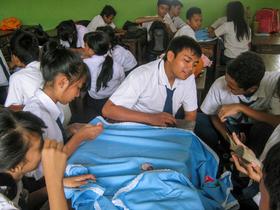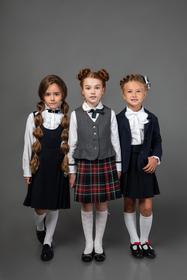Top Rankings
Gull Lake Community Schools ranks among the top 20% of public school district in Michigan for:
Category
Attribute
Overall Rank
Highest overall rank (Top 20%)
Math Proficiency
Highest math proficiency (Top 20%)
Reading/Language Arts Proficiency
Highest reading/language arts proficiency (Top 20%)
Science Proficiency
Highest science proficiency (Top 20%)
Graduation Rate
Highest graduation rate (Top 20%)
Community Size
Largest student body (number of students) (Top 1%)
For the 2025-26 school year, there are 7 public schools serving 3,322 students in Gull Lake Community Schools. This district's average testing ranking is 9/10, which is in the top 20% of public schools in Michigan.
Public Schools in Gull Lake Community Schools have an average math proficiency score of 44% (versus the Michigan public school average of 35%), and reading proficiency score of 62% (versus the 46% statewide average).
Minority enrollment is 18% of the student body (majority Hispanic), which is less than the Michigan public school average of 37% (majority Black).
Overview
This School District
This State (MI)
# Schools
7 Schools
3,506 Schools
# Students
3,322 Students
1,376,194 Students
# Teachers
208 Teachers
82,370 Teachers
Student-Teacher Ratio
16:1
16:1
Student By Grade
District Rank
Gull Lake Community Schools, which is ranked within the top 20% of all 845 school districts in Michigan (based off of combined math and reading proficiency testing data) for the 2022-2023 school year.
The school district's graduation rate of 89% has increased from 88% over five school years.
Overall District Rank
#125 out of 862 school districts
(Top 20%)
(Top 20%)
Math Test Scores (% Proficient)
44%
35%
Reading/Language Arts Test Scores (% Proficient)
61%
45%
Science Test Scores (% Proficient)
51%
38%
Graduation Rate
89%
81%
Students by Ethnicity:
Diversity Score
0.33
0.56
% American Indian
n/a
1%
% Asian
1%
4%
% Hispanic
7%
9%
% Black
3%
18%
% White
82%
63%
% Hawaiian
n/a
n/a
% Two or more races
7%
5%
All Ethnic Groups
District Revenue and Spending
The revenue/student of $15,102 in this school district is less than the state median of $18,512. The school district revenue/student has declined by 7% over four school years.
The school district's spending/student of $20,186 is higher than the state median of $17,694. The school district spending/student has declined by 7% over four school years.
Total Revenue
$50 MM
$25,476 MM
Spending
$67 MM
$24,351 MM
Revenue / Student
$15,102
$18,512
Spending / Student
$20,186
$17,694
Best Gull Lake Community Schools Public Schools (2025-26)
School
(Math and Reading Proficiency)
(Math and Reading Proficiency)
Location
Quick Facts
Rank: #11.
Gull Lake High School
(Math: 45-49% | Reading: 70-74%)
Rank:
Rank:
9/
Top 20%10
7753 N 34th St
Richland, MI 49083
(269) 548-3505
Richland, MI 49083
(269) 548-3505
Gr: 8-12 | 844 students Student-teacher ratio: 18:1 Minority enrollment: 18%
Rank: #22.
Thomas M Ryan Intermediate School
(Math: 45% | Reading: 62%)
Rank:
Rank:
8/
Top 30%10
9562 M 89
Richland, MI 49083
(269) 548-3705
Richland, MI 49083
(269) 548-3705
Gr: 3-5 | 685 students Student-teacher ratio: 16:1 Minority enrollment: 20%
Rank: #33.
Gull Lake Virtual Partnership
Alternative School
(Math: 40-49% | Reading: 60-64%)
Rank:
Rank:
8/
Top 30%10
315 Hutchinson Rd
Richland, MI 49083
(269) 548-3430
Richland, MI 49083
(269) 548-3430
Gr: K-12 | 373 students Student-teacher ratio: 16:1 Minority enrollment: 17%
Rank: #44.
Gull Lake Middle School
(Math: 42% | Reading: 58%)
Rank:
Rank:
8/
Top 30%10
9550 M 89
Richland, MI 49083
(269) 548-3605
Richland, MI 49083
(269) 548-3605
Gr: 6-8 | 682 students Student-teacher ratio: 17:1 Minority enrollment: 16%
Rank: #55.
Gull Lake Gateway Academy
Alternative School
(Math: <50% | Reading: <50% )
Rank:
Rank:
8/
Top 30%10
10100 E D Ave
Richland, MI 49083
(269) 548-3422
Richland, MI 49083
(269) 548-3422
Gr: 9-12 | 35 students Student-teacher ratio: 18:1 Minority enrollment: 28%
Rank: n/an/a
9594 N 40th St
Hickory Corners, MI 49060
(269) 548-3805
Hickory Corners, MI 49060
(269) 548-3805
Gr: PK-2 | 284 students Student-teacher ratio: 12:1 Minority enrollment: 14%
Rank: n/an/a
9476 M 89
Richland, MI 49083
(269) 548-3905
Richland, MI 49083
(269) 548-3905
Gr: PK-2 | 419 students Student-teacher ratio: 14:1 Minority enrollment: 24%
Frequently Asked Questions
How many schools belong to Gull Lake Community Schools?
Gull Lake Community Schools manages 7 public schools serving 3,322 students.
What is the rank of Gull Lake Community Schools?
Gull Lake Community Schools is ranked #129 out of 845 school districts in Michigan (top 20%) based off of combined math and reading proficiency testing data for the 2022-2023 school year. This district ranks in the top 20% of Michigan school districts for: Highest overall rank (Top 20%), Highest math proficiency (Top 20%), Highest reading/language arts proficiency (Top 20%), Highest science proficiency (Top 20%), Highest graduation rate (Top 20%) and Largest student body (number of students) (Top 1%)
What is the racial composition of students in Gull Lake Community Schools?
82% of Gull Lake Community Schools students are White, 7% of students are Hispanic, 7% of students are Two or more races, 3% of students are Black, and 1% of students are Asian.
What is the student/teacher ratio of Gull Lake Community Schools?
Gull Lake Community Schools has a student/teacher ratio of 16:1, which is lower than the Michigan state average of 17:1.
What is Gull Lake Community Schools's spending/student ratio?
The school district's spending/student of $20,186 is higher than the state median of $17,694. The school district spending/student has declined by 7% over four school years.
Recent Articles

School Vouchers: Updated Pros and Cons (2025 Review)
Comprehensive 2025 analysis of school vouchers, weighing benefits and challenges for families, funding, outcomes, and policy directions.

Benefits and Drawbacks of Homework in 2025
Explore updated 2025 insights on homework’s benefits, drawbacks, mental health impact, best practices, and policy trends in U.S. public schools.

Charter Schools vs Public Schools 2025: Key Differences & Trends
Explore updated 2025 insights comparing charter schools vs public schools, enrollment, academic outcomes, funding, and real-world examples for families and educators.





